
The black sea bass is a species of marine ray-finned fish, a sea bass from the subfamily Serraninae which is part of the family Serranidae, which also includes the groupers and anthias. It is found in the western Atlantic Ocean, where it is an important species for commercial and recreational fisheries.

The splendid toadfish also called the coral toadfish and the Cozumel splendid toadfish is a species of toadfish once believed to be entirely endemic to the island of Cozumel but have been found on the reefs of Honduras all the way up to Cancun. Commonly found under coral outcroppings. Dens can be spotted by the sloping sand patch. They are very difficult to coax out in the open.

The Cuban dogfish is a dogfish, a member of the family Squalidae in the order Squaliformes.

The bluegrey carpetshark or Colclough's shark, is an uncommon species of carpet shark endemic to shallow inshore waters off northeastern Australia. It is one of the two extant members of the family Brachaeluridae. The bluegrey carpetshark has a stocky body with a wide, slightly flattened head, dorsally placed eyes, and a pair of long barbels with posterior skin flaps. It has large pectoral fins, two dorsal fins of unequal size placed far back on the body, and a sizeable space between the anal fin and the base of the caudal fin. Growing to 76 cm (30 in) long, this species has a black-and-white colour pattern as a juvenile, which largely fades with age such as that adults are brownish.
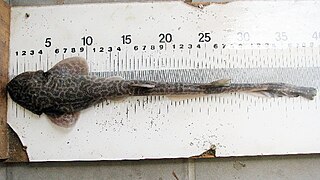
The Izak catshark or simply Izak is a species of catshark, belonging to the family Scyliorhinidae, common off the coasts of South Africa and southern Namibia. It typically inhabits the outer continental shelf at depths of 100–300 m (330–980 ft), with the males found deeper than the females and juveniles. The Izak catshark has a short, wide, flattened head and a robust body tapering to a long, slender tail. It can be identified by its ornate color pattern of dark brown spots or reticulations and blotches on a light yellowish background, as well as by the enlarged dermal denticles over its pectoral fins and along its dorsal midline from the snout to the second dorsal fin. This species reaches 69 cm (27 in) in length, with the males larger than females.
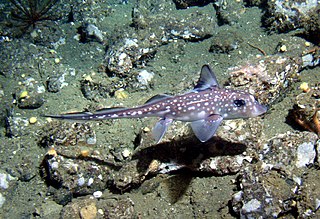
The spotted ratfish is a chimaera found in the north-eastern Pacific Ocean. Often seen by divers at night in the Pacific Northwest, this cartilaginous fish gets its characteristic name from a pointed rat-like tail. The ratfish lays leathery egg cases on the bottom of muddy or sandy areas, which are often mistaken by divers as something inanimate. While mainly a deep-water species, it occurs at shallower depths in the northern part of its range. The generic name, Hydrolagus, comes from the Greek words ὕδωρ, meaning water, and λαγώς/λαγῶς, meaning hare, and the specific name honors Alexander Collie, who was a ship surgeon and early naturalist. The spotted ratfish is common in much of its range, not typically eaten by humans, and is not commercially caught.

The pennant coralfish, also known as the longfin bannerfish, reef bannerfish or coachman, is a species of fish of the family Chaetodontidae, native to the Indo-Pacific area.
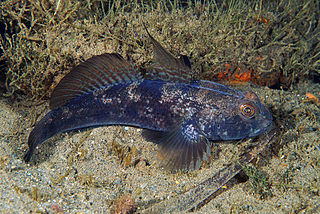
The black goby is a species of ray-finned fish found in the Eastern Atlantic and Mediterranean Sea and Black Sea. It inhabits estuaries, lagoons, and inshore water over seagrass and algae. It feeds on a variety of invertebrates and sometimes small fish. This species can also be found in the aquarium trade.
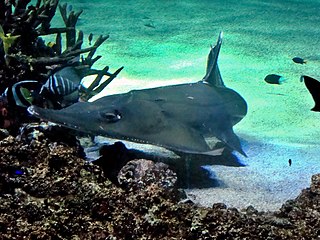
Rhynchobatus australiae, also called the white-spotted guitarfish, white-spotted wedgefish or bottlenose wedgefish, is a species of fish in the Rhinidae family. It is found from shallow waters to a depth of at least 60 m (200 ft) in the Indo-Pacific, ranging from the East African coast and the Red Sea, to Taiwan, the Philippines and Australia. It is part of a species complex that also includes the giant guitarfish, the broadnose wedgefish and possibly the smoothnose wedgefish.
The spotted dragonet is a species of dragonet native to the eastern Atlantic Ocean and the Mediterranean Sea where it occurs at depths of from 45 to 650 metres. This species is important to local peoples engaged in subsistence fishing.
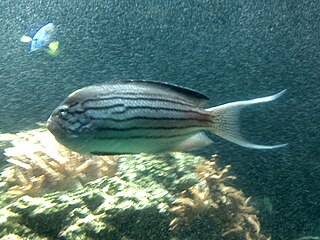
Genicanthus lamarck, the blackstriped angelfish or Lamarck's angelfish, is a species of marine ray-finned fish, a marine angelfish belonging to the family Pomacanthidae. It occurs in the Indo-West Pacific region.

The Indonesian angelshark is a rare species of angelshark, family Squatinidae, known only from a few specimens collected from fish landing sites in southern Indonesia. It is thought to inhabit the deep waters of the continental slope. Reaching at least 1.34 m (4.4 ft) long, this species has a flattened, ray-like shape and a well-developed tail and caudal fin. It is characterized by the absences of fringes on its nasal barbels and thorns down the midline of its back, as well as by its relatively plain grayish-brown dorsal coloration with dark saddles beneath the dorsal fin bases and a black leading margin on the underside of the pectoral fins. The International Union for Conservation of Nature (IUCN) has classified it as Critically Endangered due to significant fishing pressure.
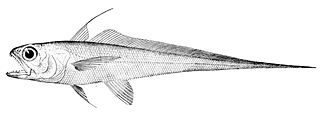
The luminous hake is a West Atlantic member of the Merluccidae family. It is the only member of its genus.

Urophycis is a genus of phycid hakes.

The whitespotted grouper, also known as the rankin cod, ocellated rockcod, small-spotted cod, white-spotted reef-cod or whitespotted rockcod, is a species of marine ray-finned fish, a grouper from the subfamily Epinephelinae which is part of the family Serranidae, which also includes the anthias and sea basses. It has an Indo-Pacific distribution. It is closely related to two other species of white spotted groupers in the genus Epinephelus.
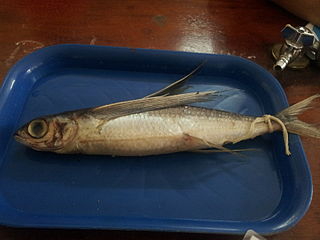
Cheilopogon nigricans, the blacksail flyingfish, also known as African flyingfish, or leaping flyingfish, is a flying fish in the family Exocoetidae. It is an oceanodromous, plankton-eating marine fish which has commercial value.
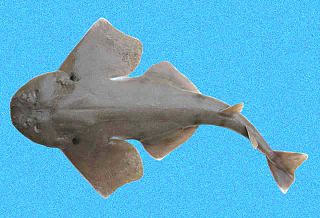
The disparate angelshark is a species of angelshark found along the East Coast of the United States and the Gulf of Mexico. It occurs at depths down to 1,290 m (4,230 ft) and reaches a length of 49 cm (19 in). Heteroptera in its name refers to the difference in size, shape and area of the two dorsal fins. Disparate angelsharks have the typical angel shark body form that is broadly flattened with large pectoral/pelvic fins and eyes and spiracles on the top of their heads. Their common and species name comes from them having dorsal fins of very different sizes, shapes, and areas compared to other angel sharks.

Diplecogaster bimaculata, the two-spotted clingfish, is a species of fish in the family Gobiesocidae found in Black Sea, Mediterranean Sea and Atlantic Ocean where it is found on rocks and among seagrass or shell beds.

The bleeding wrasse is a species of marine ray-finned fish from the family Labridae, the wrasses. It is found in reefs in the eastern central Pacific Ocean.

Lepidotrigla spiloptera, the spotwing gurnard, spotfin gurnard or red-fringed gurnard, is a species of marine, demersal ray-finned fish from the family Triglidae, the gurnards and sea robins. It has a wide Indo-Pacific distribution.
"The Inland Fishes of New York State." C. Lavett Smith.




















